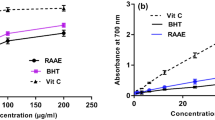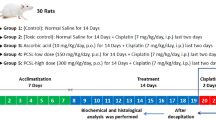Abstract
The present study was aimed to assess the nephroprotective effect of Cressa cretica hydroalcoholic extract (CCE) on VAN-triggered renal toxicity in rabbits. Total phenolic and flavonoid contents found in CCE were 30.92 ± 2.93 mg GAE/g extract and 11.87 ± 1.70 mg CE/g extract, respectively. The CCE demonstrated a significant 2,2-diphenyl-1-picrylhydrazyl radical (DPPH*) scavenging ability with an IC50 value of 24.99 µg/mL. To evaluate the nephroprotective potential of CCE, thirty-six rabbits were divided into six groups (n = 6) and treated for consecutive 14 days as G-I: normal control, G-II: vehicle control (VAN 200 mg/kg, i.p.), G-III: SIL (silymarin 150 mg/kg, i.g. + VAN-treated), and G-IV to VI: CCE at 200, 400, and 600 mg/kg, i.g. + VAN-treaded groups. Blood samples were withdrawn at the 0th, 7th, and 14th days of the experiment for biochemical analysis, and renal tissues were collected at the end of experiment for antioxidant/oxidant markers and histopathological assessments. VAN significantly (P < 0.05) elevated serum levels of creatinine, blood urea nitrogen (BUN), and urea. The CCE co-administration significantly (P < 0.05) decreased the renal function markers elevated by VAN. A significantly (P < 0.05) decreased total antioxidant capacity (TAC) level, superoxide dismutase (SOD) and catalase (CAT) activities, and raised malondialdehyde (MDA) level in serum and kidney tissues were normalized in CCE-treated groups. Histopathological examination showed that CCE (600 mg/kg, i.g.) caused a mark reduction in inflammatory cell infiltration, glomerular damage, and tubular vacuolization in renal tissues of VAN-treated groups, comparable to SIL. Furthermore, CCE at 200, 400, and 600 mg/kg ameliorated VAN-induced nephrotoxicity in a dose-dependent manner. This study demonstrates the protective effect of CCE on VAN-induced nephrotoxicity by ameliorating renal function markers and suppressing oxidative stress.





Similar content being viewed by others
Availability of data and materials
The dataset used and analyzed during the current study are available as supplementary material.
Abbreviations
- AA:
-
Ascorbic acid
- BUN:
-
Blood urea nitrogen
- CCE:
-
C. cretica Hydroalcoholic extract
- CAT:
-
Catalase
- CE:
-
Catechin equivalent
- DPPH:
-
2,2-Diphenyl-1-picrylhydrazyl
- GAE:
-
Gallic acid equivalent
- MDA:
-
Malondialdehyde
- SIL:
-
Silymarin
- SOD:
-
Superoxide dismutase
- TAC:
-
Total antioxidant capacity
- TFC:
-
Total flavonoid content
- TPC:
-
Total phenolic content
- VAN:
-
Vancomycin
References
Abdallah HMI, Elshamy AI, El Gendy AENG, Abd El-Gawad AM, Omer EA, De Leo M, Pistelli L (2017) Anti-inflammatory, antipyretic, and antinociceptive effects of a Cressa cretica aqueous extract. Planta Med 83(17):1313–1320. https://doi.org/10.1055/s-0043-108650
Abdel-Daim MM, Ahmed A, Ijaz H, Abushouk AI, Ahmed H, Negida A, Aleya L, Bungau SG (2019) Influence of Spirulina platensis and ascorbic acid on amikacin-induced nephrotoxicity in rabbits. Environ Sci Pollut Res 26(8):8080–8086. https://doi.org/10.1007/s11356-019-04249-4
Afshari A, Sayyed-Alangi SZ (2017) Antioxidant effect of leaf extracts from Cressa cretica against oxidation process in soybean oil. Food Sci Nutr 5(2):324–333. https://doi.org/10.1002/fsn3.396
Amien AI, Fahmy SR, Abd-Elgleel FM, Elaskalany SM (2015) Renoprotective effect of Mangifera indica polysaccharides and silymarin against cyclophosphamide toxicity in rats. J Basic Appl Zool 72:154–162. https://doi.org/10.1016/j.jobaz.2015.09.006
Anwar M, Muhammad F, Akhtar B, Ur Rehman S, Saleemi MK (2020) Nephroprotective effects of curcumin loaded chitosan nanoparticles in cypermethrin induced renal toxicity in rabbits. Environ Sci Pollut Res 27(13):14771–14779. https://doi.org/10.1007/s11356-020-08051-5
Athira KV, Madhana RM, Lahkar M (2016) Flavonoids, the emerging dietary supplement against cisplatin-induced nephrotoxicity. Chem Biol Interact 248:18–20. https://doi.org/10.1016/j.cbi.2016.02.005
Bagheri G, Ayatollahi SA, Ramírez-Alarcón K, Fernández M, Salehi B, Forman K, Martorell M, Sharifi-Rad J (2020) Phytochemical screening of Alstonia scholaris leaf and bark extracts and their antimicrobial activities. Cell Mol Biol (Noisy-le-grand) 66(4):270–279. https://doi.org/10.14715/cmb/2020.66.4.27
Bamgbola O (2016) Review of vancomycin induced renal toxicity: An update. Ther Adv Endocrinol Metab 7(3):136–147. https://doi.org/10.1177/2042018816638223
Barceló-Vidal J, Rodríguez-García E, Grau S (2018) Extremely high levels of vancomycin can cause severe renal toxicity. Infect Drug Resist 11:1027–1030. https://doi.org/10.2147/IDR.S171669
Basarslan F, Yilmaz N, Ates S, Ozgur T, Tutanc M, Motor VK, Arica V, Yilmaz C, Inci M, Buyukbas S (2012) Protective effects of thymoquinone on vancomycin-induced nephrotoxicity in rats. Hum Exp Toxicol 31(7):726–733. https://doi.org/10.1177/0960327111433185
Beauchamp C, Fridovich I (1971) Superoxide dismutase: improved assays and an assay applicable to acrylamide gels. Anal Biochem 44(1):276–287. https://doi.org/10.1016/0003-2697(71)90370-8
Çağlayan C, Taslimi P, Demir Y, Küçükler S, Kandemir FM, Gulçin İ (2019) The effects of zingerone against vancomycin-induced lung, liver, kidney and testis toxicity in rats: The behavior of some metabolic enzymes. J Biochem Mol Toxicol 33(10):e22381. https://doi.org/10.1002/jbt.22381
Claiborne A (1985) Catalase activity. In: Greenwald RA (ed) CRC handbook of methods for oxygen radical research. CRC, Boca Raton, pp 283–284
Elyasi S, Khalili H, Hatamkhani S, Dashti-Khavidaki S (2013) Prevention of vancomycin induced nephrotoxicity: a review of preclinical data. Eur J Clin Pharmacol 69(4):747–754. https://doi.org/10.1007/s00228-012-1406-3
Erel O (2004) A novel automated method to measure total antioxidant response against potent free radical reactions. Clin Biochem 37(2):112–119. https://doi.org/10.1016/j.clinbiochem.2003.10.014
Farag RS, Abdel-Latif MS, Abd-El-Baky HH, Tawfeek LS (2020) Phytochemical screening and antioxidant activity of some medicinal plants’ crude juices. Biotechnol Rep 28:e00536. https://doi.org/10.1016/j.btre.2020.e00536
Filippone EJ, Kraft WK, Farber JL (2017) The nephrotoxicity of vancomycin. Clin Pharmacol Ther 102(3):459–469. https://doi.org/10.1002/cpt.726
Giannopolitis CN, Ries SK (1977) Superoxide dismutases: II. Purification and quantitative relationship with water-soluble protein in seedlings. Plant Physiol 59(2):315–318. https://doi.org/10.1104/pp.59.2.315
Goth L (1991) A simple method for determination of serum catalase activity and revision of reference range. Clin Chim Acta 196(2–3):143–151. https://doi.org/10.1016/0009-8981(91)90067-M
Hasanein P, Riahi H (2017) Preventive use of berberine in inhibition of lead-induced renal injury in rats. Environ Sci Pollut Res Int 25(5):4896–4903. https://doi.org/10.1007/s11356-017-0702-y
Humanes B, Jado JC, Camaño S, López-Parra V, Torres AM, Álvarez-Sala LA, Cercenado E, Tejedor A, Lázaro A (2015) Protective effects of cilastatin against vancomycin-induced nephrotoxicity. BioMed Res Int 1–12. https://doi.org/10.1155/2015/704382
Hussain A, Aslam B, Gilani MM, Khan JA, Anwar MW (2019) Biochemical and histopathological investigations of hepatoprotective potential of Phoenix dactylifera against isoniazid induced toxicity in animal model. Pak J Agri Sci 56(2):489–493. https://doi.org/10.21162/PAKJAS/19.6097
Karahan I, Ateşşahin A, Yılmaz S, Çeribaşı A, Sakin F (2005) Protective effect of lycopene on gentamicin-induced oxidative stress and nephrotoxicity in rats. Toxicol 215(3):198–204. https://doi.org/10.1016/j.tox.2005.07.007
Kaur C, Kapoor HC (2002) Anti-oxidant activity and total phenolic content of some Asian vegetables. Int J Food Sci Technol 37(2):153–161. https://doi.org/10.1046/j.1365-2621.2002.00552.x
King DW, Smith MA (2004) Proliferative responses observed following vancomycin treatment in renal proximal tubule epithelial cells. Toxicol in Vitro 18(6):797–803. https://doi.org/10.1016/j.tiv.2004.03.013
Koracevic D, Koracevic G, Djordjevic V, Andrejevic S, Cosic V (2001) Method for the measurement of antioxidant activity in human fluids. J Clin Pathol 54(5):356–361. https://doi.org/10.1136/jcp.54.5.356
Kumari BL, Sree KS, Choudri SR, Babu PNA (2016) Experimental evidences of methanolic extraction of Cressa cretica Linn. on alloxan induced hyperglycemic Wistar rats. Perspect Sci 8:179–182. https://doi.org/10.1016/j.pisc.2016.04.027
Mahmod II, Ismail IS, Alitheen NB, Normi YM, Abas F, Khatib A, Latip J (2020) NMR and LCMS analytical platforms exhibited the nephroprotective effect of Clinacanthus nutans in cisplatin-induced nephrotoxicity in the in vitro condition. BMC Complement Med Ther 20(1):1–18. https://doi.org/10.1186/s12906-020-03067-3
Malkani N, Naeem A, Ijaz F, Mumtaz S, Ashraf S, Sohail MI (2020) Silybum marianum (milk thistle) improves vancomycin induced nephrotoxicity by downregulating apoptosis. Mol Biol Rep 47(7):5451–5459. https://doi.org/10.1007/s11033-020-05635-9
Modarresi M, Hosseinzadeh L, Nematy N, Siavash-Haghighi ZM, Ghanbari K (2014) Acute and subchronic toxicological evaluation of Stachys lavandulifolia aqueous extract in Wistar rats. Res Pharm Sci 9(3):165–172
Moore K, Roberts LJ (1998) Measurement of lipid peroxidation. Free Radic Res 28(6):659–671. https://doi.org/10.3109/10715769809065821
Naseer A, Hussain A, Aslam B, Muhammad F, Mohsin M, Bari MU, Sultana A, Masood A (2020) Vitamin E and selenium attenuate hepatotoxicity, nephrotoxicity and oxidative stress induced by rifampicin in rabbits. Pak Vet J 40(3):277–282. https://doi.org/10.29261/pakvetj/2020.026
Nishino Y, Takemura S, Minamiyama Y, Hirohashi K, Ogino T, Inoue M, Okada S, Kinoshita H (2003) Targeting superoxide dismutase to renal proximal tubule cells attenuates vancomycin-induced nephrotoxicity in rats. Free Radic Res 37(4):373–379. https://doi.org/10.1080/1071576031000061002
Ohkawa H, Ohishi N, Yagi K (1979) Assay for lipid peroxides in animal tissues by thiobarbituric acid reaction. Anal Biochem 95(2):351–358. https://doi.org/10.1016/0003-2697(79)90738-3
Oktay M, Gulcin I, Kufrevioglu OI (2003) Determination of in vitro antioxidant activity of fennel (Foeniculum vulgare) seed extracts. LWT-Food Sci Technol 36(2):263–271. https://doi.org/10.1016/S0023-6438(02)00226-8
Oktem F, Arslan MK, Ozguner F, Candir Ö, Yilmaz HR, Ciris M, Uz E (2005) In vivo evidences suggesting the role of oxidative stress in pathogenesis of vancomycin-induced nephrotoxicity: protection by erdosteine. Toxicology 215(3):227–233. https://doi.org/10.1016/j.tox.2005.07.009
Priyashree S, Jha S, Pattanayak SP (2012) Bronchodilatory and mast cell stabilising activity of Cressa cretica L.: evaluation through in vivo and in vitro experimental models. Asian Pac J Trop Med 5(3):180–186. https://doi.org/10.1016/S1995-7645(12)60021-2
Qu S, Dai C, Lang F, Hu L, Tang Q, Wang H, Zhang Y, Hao Z (2019) Rutin attenuates vancomycin-induced nephrotoxicity by ameliorating oxidative stress, apoptosis, and inflammation in rats. Antimicrob Agents Chemother 63(1):e01545-e1618. https://doi.org/10.1128/AAC.01545-18
Shahat AA, Abdel-Azim NS, Pieters L, Vlietinck AJ (2004) Flavonoids from Cressa cretica. Pharm Biol 42(4–5):349–352. https://doi.org/10.1080/13880200490519622
Sultana B, Anwar F, Ashraf M (2009) Effect of extraction solvent/technique on the antioxidant activity of selected medicinal plant extracts. Molecules 14(6):2167–2180. https://doi.org/10.3390/molecules14062167
Tasneem S, Liu B, Li B, Choudhary MI, Wang W (2019) Molecular pharmacology of inflammation: medicinal plants as anti-inflammatory agents. Pharmacol Res 139:126–140. https://doi.org/10.1016/j.phrs.2018.11.001
Uckun Z, Guzel S, Canacankatan N, Yalaza C, Kibar D, Coskun Yilmaz B (2020) Potential protective effects of naringenin against vancomycin-induced nephrotoxicity via reduction on apoptotic and oxidative stress markers in rats. Drug Chem Toxicol 43(1):104–111. https://doi.org/10.1080/01480545.2018.1512612
Vargas F, Romecín P, García-Guillén AI, Wangesteen R, Vargas-Tendero P, Paredes MD, Atucha NM, García-Estañ J (2018) Flavonoids in kidney health and disease. Front Physiol 9:394. https://doi.org/10.3389/fphys.2018.00394
Author information
Authors and Affiliations
Contributions
Study design: FS, BA, and FM. Conducted study and collected data: FS, MNF, AH, and MUB. Interpretation of results: BA, FM, and MNF. Manuscript-writing: FS, AH, and MUB. Manuscript-proof reading: BA and FM.
Corresponding author
Ethics declarations
Ethical approval
This study was conducted with the approval of Institutional Biosafety Committee (No. DGS/4309–12), University of Agriculture, Faisalabad, Pakistan, and guidelines of NIH (publication No. 85–23, revised 2002) were followed.
Competing interests
The authors declare no competing interests.
Additional information
Publisher's Note
Springer Nature remains neutral with regard to jurisdictional claims in published maps and institutional affiliations.
Highlights
• C. cretica contains considerable polyphenol and flavonoid contents.
• C. cretica exhibits significant free radical scavenging potential.
• C. cretica extract protects against VAN-induced renal injury.
• C. cretica extract ameliorates VAN-induced oxidative stress.
Rights and permissions
About this article
Cite this article
Subhan, F., Aslam, B., Muhammad, F. et al. The efficiency of Cressa cretica (Linn.) extract in attenuating vancomycin-induced nephrotoxicity and oxidative stress in rabbits. Comp Clin Pathol 30, 829–839 (2021). https://doi.org/10.1007/s00580-021-03263-8
Received:
Accepted:
Published:
Issue Date:
DOI: https://doi.org/10.1007/s00580-021-03263-8




